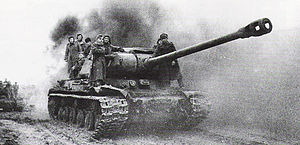Loading AI tools
Soviet military offensive 1944–1945 From Wikipedia, the free encyclopedia
The Budapest offensive was the general attack by Soviet and Romanian armies against Hungary and their Axis allies from Nazi Germany. The offensive lasted from 29 October 1944 until the fall of Budapest on 13 February 1945. This was one of the most difficult and complicated offensives that the Soviet Army carried out in Central Europe. It resulted in a decisive victory for the USSR, as it greatly sped up the ending of World War II in Europe.[5]
| Budapest offensive | |||||||
|---|---|---|---|---|---|---|---|
| Part of the Eastern Front of World War II | |||||||
 Soviet IS-2 tank in action (Battle of Budapest) | |||||||
| |||||||
| Belligerents | |||||||
|
|
| ||||||
| Commanders and leaders | |||||||
|
|
| ||||||
| Units involved | |||||||
| Casualties and losses | |||||||
|
Soviet: 80,026 dead and missing 240,056 wounded and sick Total casualties: 320,082 (including 260,000 combat casualties) 1,766 tanks destroyed 4,127 guns and mortars 293 aircraft 135,100 small arms[1][2][3] |
Siege of Budapest: 125,000 combat casualties[1] (48,000 killed, 26,000 wounded, 51,000 captured) Total: ~270,000 combat casualties | ||||||
|
76,000 civilian dead[4] 38,000 civilians dead in the siege (7,000 executed) 38,000 died in labour or POW camps | |||||||
Having secured Romania in the summer Iasi–Kishinev offensive, the Soviet forces continued their push in the Balkans. The Red Army occupied Bucharest on 31 August, then swept westward across the Carpathian Mountains into Hungary and southward into Bulgaria, with parts joining the Yugoslav Partisans in the Belgrade offensive. In the process, the Red Army's forces drew German reserves away from the Warsaw-Berlin central axis, encircled and destroyed the 6th Army (for the second time) and forced Army Group South Ukraine’s shattered 8th Army to withdraw west into Hungary.

From October 1944, the 2nd, 3rd, and 4th Ukrainian Fronts advanced into Hungary. After isolating the Hungarian capital city in late December, the Soviets besieged and assaulted Budapest. On 13 February 1945, the city fell.
According to the historical documents, the Budapest offensive can be divided into five periods:[6]
After the Budapest offensive, the main forces of Army Group South virtually collapsed. The road to Vienna, Czechoslovakia and the southern border of Germany was widely open for the Soviets and their allies.[5]
According to Soviet claims, the Germans and Hungarians in Budapest lost 49,000 dead soldiers, with 110,000 captured and 269 tanks destroyed.[8]
As most of the German forces in the region were destroyed, troops were rushed in from the Western Front and, in March, the Germans launched the ill-fated Operation Spring Awakening (Unternehmen Frühlingserwachen) in the Lake Balaton area. The expansive goals of this operation were to protect one of the last oil producing regions available to the Axis and to retake Budapest. Neither goal was achieved.
In Soviet propaganda, this offensive (together with the Belgrade Offensive and the East Carpathian Offensive) was listed as one of Stalin's ten blows.
Seamless Wikipedia browsing. On steroids.
Every time you click a link to Wikipedia, Wiktionary or Wikiquote in your browser's search results, it will show the modern Wikiwand interface.
Wikiwand extension is a five stars, simple, with minimum permission required to keep your browsing private, safe and transparent.